-
Membership
Membership
Anyone with an interest in the history of the built environment is welcome to join the Society of Architectural Historians -
Conferences
Conferences
SAH Annual International Conferences bring members together for scholarly exchange and networking -
Publications
Publications
Through print and digital publications, SAH documents the history of the built environment and disseminates scholarshipLatest Issue:

-
Programs
Programs
SAH promotes meaningful engagement with the history of the built environment through its programsMember Programs
-
Jobs & Opportunities
Jobs & Opportunities
SAH provides resources, fellowships, and grants to help further your career and professional life -
Support
Support
We invite you to support the educational mission of SAH by making a gift, becoming a member, or volunteering -
About
About
SAH promotes the study, interpretation, and conservation of the built environment worldwide for the benefit of all
Naples and Campania, Day One, 13 May 2008
by: Mia Reinoso Genoni
miagenoni@post.harvard.edu
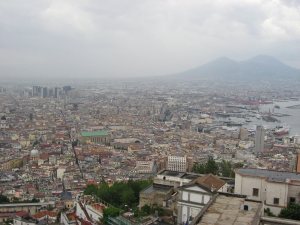
The tour began the afternoon of the 13th, with a ride on the Naples funicular, immortalized in the 19th-century song Funiculi, Funicula (lyrics and music by Peppino Turco and Luigi Denza ). We went to the top of the Vomero Hill, where we were treated to a panoramic view of the city of Naples with Vesuvius looming in the distance.
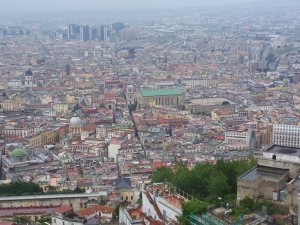
Of particular interest is the view of the Spaccanapoli, or “Naples-Splitter”; one of the original east-west streets of the Greek city of Neapolis, it became a Roman decumanus, and is now known as the via Benedetto Croce. The building with the green roof is the late medieval church of Santa Chiara.
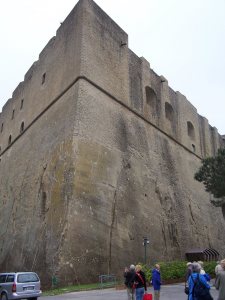
The spatio-temporal layering visible from Vomero hill is also omnipresent in the structures atop it. The Castel Sant’Elmo is a fortress named after a 10th-century church on site. It was begun by King Robert of Anjou in 1329, and the Viceroy Peter of Toledo reconfigured it in 1537-46. It was built in part by slicing through the rock to create what is essentially a moat without water.
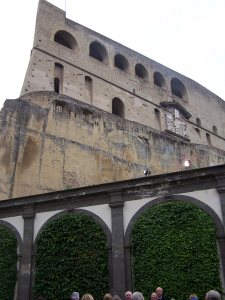
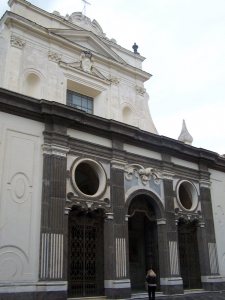
The Certosa di San Martino is a Carthusian monastery founded by Charles of Anjou, Duke of Calabria in 1325. In the 16th and 17th centuries two architects were responsible for a complete renovation, originally inspired in part by the Counter-Reformation: Giovanni Antonio Dosio (1589) and Cosimo Fanzago (1623).
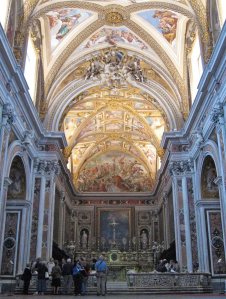
The interior is a testament to Mannerist and Baroque Neapolitan splendor, as well as a palimpsest of sorts: note Giovanni Lanfranco’s 17th-century frescoes inserted into the “Gothic” (or “medieval modern”) vaulting of the Angevin structure. Also fascinating is Fanzago’s use of marble. There were no nearby quarries, so marble came at a premium; Fanzago the sculptor solved this problem by creating slender marble revetment, seen here.
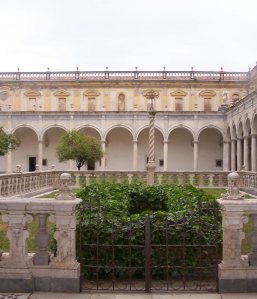
The Chiostro Grande was designed by Dolsio in 1591-1609. Fanzago created the balustrade of the monk’s cemetery, seen here in the foreground.

Examples of his deft architectonic-sculptural touch abound: here we see the skulls of the balustrade of the cemetery…

while elsewhere we find the elements of greater articulation he added to Dosio’s design. Quite striking are the elegant moldings that frame the busts of Carthusian saints found on the portals.
miagenoni@post.harvard.edu

The tour began the afternoon of the 13th, with a ride on the Naples funicular, immortalized in the 19th-century song Funiculi, Funicula (lyrics and music by Peppino Turco and Luigi Denza ). We went to the top of the Vomero Hill, where we were treated to a panoramic view of the city of Naples with Vesuvius looming in the distance.

Of particular interest is the view of the Spaccanapoli, or “Naples-Splitter”; one of the original east-west streets of the Greek city of Neapolis, it became a Roman decumanus, and is now known as the via Benedetto Croce. The building with the green roof is the late medieval church of Santa Chiara.

The spatio-temporal layering visible from Vomero hill is also omnipresent in the structures atop it. The Castel Sant’Elmo is a fortress named after a 10th-century church on site. It was begun by King Robert of Anjou in 1329, and the Viceroy Peter of Toledo reconfigured it in 1537-46. It was built in part by slicing through the rock to create what is essentially a moat without water.


The Certosa di San Martino is a Carthusian monastery founded by Charles of Anjou, Duke of Calabria in 1325. In the 16th and 17th centuries two architects were responsible for a complete renovation, originally inspired in part by the Counter-Reformation: Giovanni Antonio Dosio (1589) and Cosimo Fanzago (1623).

The interior is a testament to Mannerist and Baroque Neapolitan splendor, as well as a palimpsest of sorts: note Giovanni Lanfranco’s 17th-century frescoes inserted into the “Gothic” (or “medieval modern”) vaulting of the Angevin structure. Also fascinating is Fanzago’s use of marble. There were no nearby quarries, so marble came at a premium; Fanzago the sculptor solved this problem by creating slender marble revetment, seen here.

The Chiostro Grande was designed by Dolsio in 1591-1609. Fanzago created the balustrade of the monk’s cemetery, seen here in the foreground.

Examples of his deft architectonic-sculptural touch abound: here we see the skulls of the balustrade of the cemetery…

while elsewhere we find the elements of greater articulation he added to Dosio’s design. Quite striking are the elegant moldings that frame the busts of Carthusian saints found on the portals.


Leave a commentOrder by
Newest on top Oldest on top